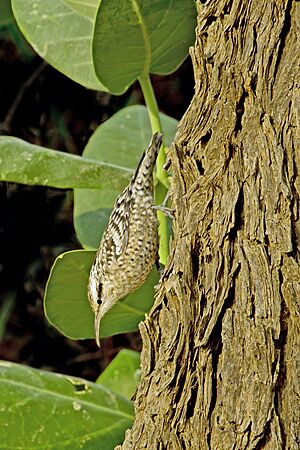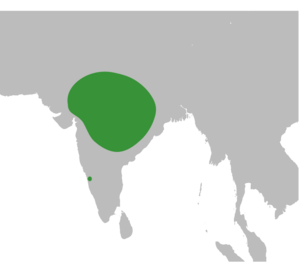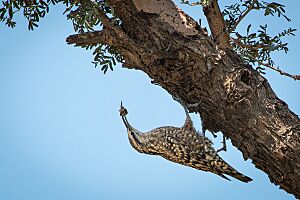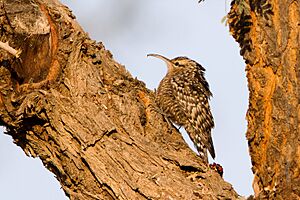Indian spotted creeper facts for kids
Quick facts for kids Indian spotted creeper |
|
|---|---|
 |
|
| In Churu, Rajasthan, India | |
| Conservation status | |
| Scientific classification | |
 |
|
| Synonyms | |
|
The Indian spotted creeper (Salpornis spilonota) is a small passerine bird, also known as a songbird. It belongs to a group of birds called Salpornithinae. This group is often placed with the treecreepers in the family Certhiidae.
This little bird has a unique black and white marbled pattern on its feathers. This special coloring helps it blend in with the dark, rough bark of trees. It uses its curved beak to find and pull out insects from the tree trunks. You can find the Indian spotted creeper in dry scrublands and open forests. It lives in different parts of northern and central India. Unlike some birds, it does not migrate to other places for the winter.
Contents
What Does the Indian Spotted Creeper Look Like?
The Indian spotted creeper has feathers that are spotted and barred with grey and white. This makes it look quite different from other treecreepers. It can weigh up to 16 grams. This is about twice as much as other treecreepers of a similar size.
This bird has a thin, pointed beak that curves downwards. Its beak is a bit longer than its head. It uses this beak to pull insects out of tree bark. Unlike true treecreepers, it does not have stiff tail feathers. Treecreepers use their stiff tails to help them climb straight up tree trunks.
The Indian spotted creeper has a white stripe above its eye. This stripe stands out against a dark stripe through its eye. Its throat is also white. Its wings are long and pointed. The tail has twelve feathers and looks square-shaped. Male and female Indian spotted creepers look the same.
How Scientists Named This Bird
This bird was first described by Major James Franklin in 1831. He gave it the name Certhia spilonota. He noticed that its tail feathers were not stiff like other birds in the Certhia group. Later, George Robert Gray created a new group, or genus, called Salpornis. He then placed this bird in that new group as Salpornis spilonota.
When similar birds were found in Africa, they were first thought to be the same species. However, in 2010, scientists studied them more closely. They looked at their genes, how they looked, and their calls. They found that the African birds were actually different species.
Sometimes, the scientific name was changed to spilonotus. This was to match the gender of the genus Salpornis. But in 2014, scientists decided to go back to the original spelling, spilonota. This is because the species name should not change. Older books might call this bird the "spotted grey creeper."
Scientists are still studying how the Indian spotted creeper is related to other birds. It is placed in the family Certhiidae, which includes treecreepers. However, some studies suggest it might be more closely related to nuthatches or even the wallcreeper.
Where Do Indian Spotted Creepers Live?
The Indian spotted creeper is not a very common bird. It lives in different scattered places across India. You can find it in parts of Rajasthan, Gujarat, and Uttar Pradesh. It also lives in central India, including areas like Bandhavgarh.
In the past, some scientists thought the birds in the Aravalli hills were a separate type. But now, they are considered part of the same group.
These birds mostly live in places with trees that have deeply cracked bark. They like trees such as Acacia, Diospyros, Tectona, and mango trees.
Behaviour and Life Cycle
You can often see the Indian spotted creeper alone. Sometimes, it joins groups of different bird species. It climbs up tree trunks, starting from the bottom. It can also move along horizontal branches. When it flies down to the base of a tree, it might look a bit clumsy.
These birds move up and down tree trunks in a way that reminds some people of nuthatches. They do not climb in a spiral like treecreepers. They also hold their tail away from the tree. Sometimes, they even hang upside down! They eat small insects and spiders that they find on the bark.
The calls of the Indian spotted creeper sound like rising tui-tui-tui notes. Their song is a sad series of whistles, like tsip-tsee tuu tuui-tuwee. It can sound a bit like a sunbird's song.
Reproduction
The breeding season for the Indian spotted creeper is from February to May. They build their nests in a cup shape. The nest is made from roots and plant stalks. They usually place it where a horizontal branch meets the main tree trunk. They often choose a spot near a knot or bump on the tree. This makes the nest very hard to see.
The nest walls are soft but strong. The outside of the nest is decorated with spider webs, caterpillar droppings, and lichen. The inside is lined with spider webs and other soft materials. A female bird usually lays two eggs. The eggs are greenish or grey with darker brown spots.
Only the female bird sits on the eggs to keep them warm. The male bird brings her food. They stay in touch with a soft twittering call. Both parents help feed the baby birds once they hatch.
Images for kids








